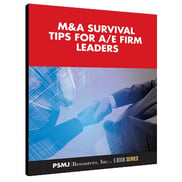
On the surface, the change from owner to employee may not seem like a big deal to a prospective seller, and it may not even be on the radar screen of the buyer. However, it is an important and multifaceted issue.
 PSMJ’s M&A Consultant Brad Wilson often encounters firm principals who are ready to sell their firms, but find it hard to accept the realities of becoming an employee. “Many firm owners can’t remember the last time they had a boss and are rightfully nervous about becoming an employee again,” says Wilson. He sees three common issues associated with this change, and warns if these issues aren’t addressed, they can create serious setbacks in the integration process:
PSMJ’s M&A Consultant Brad Wilson often encounters firm principals who are ready to sell their firms, but find it hard to accept the realities of becoming an employee. “Many firm owners can’t remember the last time they had a boss and are rightfully nervous about becoming an employee again,” says Wilson. He sees three common issues associated with this change, and warns if these issues aren’t addressed, they can create serious setbacks in the integration process:
-
The loss of “total” autonomy. Many entrepreneurs struggle with this change. For too many years, they have followed their own vision, made the key decisions, and thought of themselves as the leader. Others have thought of them as the leader, too, but once the firm is sold, their loyalty shifts toward the new owner. If you plan on handing the reins over to a new owner, will you be happy and effective in your new role?
-
The fact that the buyer will expect the selling principal to help ensure that profit targets are achieved. “During early meetings with a potential buyer, clarify the roles the buyer expects you and other current principals to play,” says Wilson. “These responsibilities should be clearly defined as early in the process as possible.”
-
The loss of year-end shareholder distributions or other discretionary compensation. This loss of annual income can be quite substantial in some cases depending on the past compensation practices of the selling firm.
Advice for buyers
Buyers can help by being sensitive to the sellers’ situation and by spending time throughout the integration planning process addressing the seller’s concerns. This is by no means an easy
task, considering the fact that many members of the buyers’ acquisition team have most likely never been a small firm owner or even in a small firm setting. But, if the buyer does not make an effort to help the seller through this awkward transition, the merger or acquisition can be all for naught.
Wilson points out a recent acquisition gone awry because the buyer wouldn’t budge. “We had a potential deal come apart because the 100% owner of the selling firm was struggling to accept accountability for performance. But, at the same time, the large buyer firm was not willing to make any allowances within their corporate structure. If they would have allowed for a few ‘special’ conditions to exist for the seller, they may have soothed some of the seller's fear of having a boss to answer to.
“Sellers need to be reassured by buyers that they will remain ‘relevant’ within the operation. How each chooses to define relevance is will vary, but buyers need to understand that in most cases an acquired 100% owner — especially a firm founder — is never going to be happy as just another employee,” says Wilson. “Big company rules may need to be bent at times to create a situation that gives the seller time to adjust to his or her new situation.”
Advice for sellers
Just as buyers must be sensitive to a sellers transitioning from owner to employee, sellers need to come to grips with the fact that his or her new role will look very different.
When working with selling firms, Wilson spends extra time preparing principals for becoming an employee. “We put the seller through an ‘are you really ready’ inquisition before beginning the process of soliciting buyers. These sellers may always say they are ready, but it is important that they hear the harsh reality of a loss of total autonomy.
“Also, many sellers feel a sense of responsibility to their employees that makes it hard to trust another firm with their well-being, so we share as many success stories as we can to show that bigger firms will value their employees as well.”
Bottom line
Sellers need to understand what the change from owner to employee really involves and buyers need to understand that this change is not an easy one to make. Again, addressing these and other seller concerns early in the acquisition process will help ease the pain of integration.
 Merger & Acquisition (M&A) activity in the architecture and engineering space is certainly on the upswing and well on its way to reaching pre-recession levels. But, how ready are you for taking on the task of buying or selling an A/E firm? If you are looking for tips to help your firm navigate through the M&A process, check out PSMJ complimentary ebook M&A Survival Tips for A/E Firm Leaders.
Merger & Acquisition (M&A) activity in the architecture and engineering space is certainly on the upswing and well on its way to reaching pre-recession levels. But, how ready are you for taking on the task of buying or selling an A/E firm? If you are looking for tips to help your firm navigate through the M&A process, check out PSMJ complimentary ebook M&A Survival Tips for A/E Firm Leaders. 
Other M&A Related Posts
Getting Ready to Sell? Think Like a Buyer!
What You Must Know About Private Equity
Growing Revenue = Growing Valuation? Be Careful What You Wish For!
Expert Interview: Assessing Current M&A Market Conditons and Trends
How prepared are A/E firm leaders to undertake M&A?



